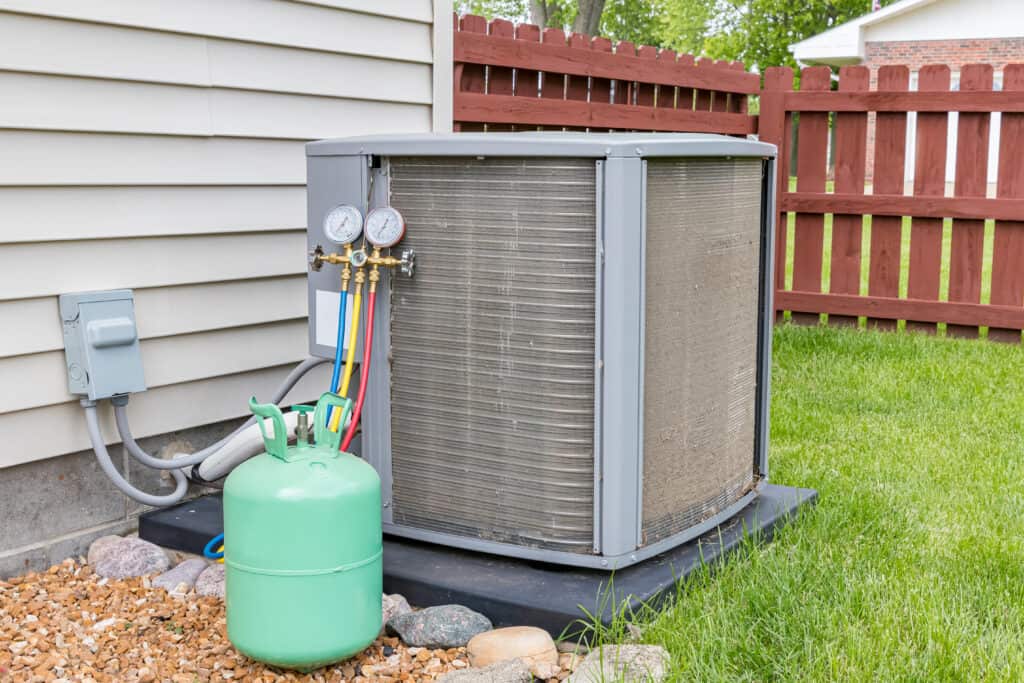What is Refrigerant and Why is it in Air Conditioners?
The next time you’re enjoying the cool inside of a home or office on a warm day, thank chemistry. Well, thank the AC refrigerant flowing inside the air conditioning system.
Here we’ll discuss what refrigerant is, how it works, the four main types, and signs there’s a problem with the refrigerant in your AC system.
What is Refrigerant?
It’s the chemical substance inside an air conditioner — and any appliance that cools — that makes a cool home or business possible. To work correctly, each air conditioner is charged or loaded with an amount of refrigerant appropriate for the overall unit size. The manufacturer sets these amounts.
How Does Refrigerant Work?
The refrigerant flows through the coils inside the AC system and undergoes four changes in its chemical state during the cycle.
The pressure decreases but its state changes from liquid to saturated vapor as the refrigerant enters the evaporator. There it absorbs heat from the air, begins to boil, and turns back to low-pressure superheated gas. The process creates cool air, which is blown back into the ductwork and your home or business. Then, the gas goes back into the compressor, and the cooling cycle begins again.
What are the different types of refrigerants?
First developed in 1928, refrigerants have provided indoor comfort for nearly 100 years. In that time, they’ve changed and been outright banned for environmental reasons. To find out what type of refrigerant your air conditioner uses, look for the appliance description sticker on the outdoor condenser unit. It will also be listed in the owner’s manual.
Chlorofluorocarbons (CFCs)
Commonly known as Freon™, CFCs were a common refrigerant until 1995, when they were phased out. Scientific evidence and studies have shown they played a crucial role in the depletion of the Earth’s ozone layer and increasing greenhouse gas in the atmosphere.
R22 Refrigerant
R22 refrigerant, or Freon™ 22, was the standard refrigerant in ACs from 1960 until 2010, when it was banned for use in new systems. That said, it was also linked to environmental damage like its predecessor. R22 is a CFC with an added hydrogen atom to shorten its ecological lifespan.
R410A Refrigerant
When R22 refrigerant was banned, manufacturers introduced R410A or Puron. This chlorine-free refrigerant has a significantly lower environmental impact but retains its cooling qualities. One significant benefit to Puron is a higher Seasonal Energy Efficiency Ratio (SEER) for the AC system, along with improved indoor comfort and air quality. A higher SEER rating also means lower cooling costs for you.
R32 Refrigerant
Given its moniker as the future of refrigerants, R32 is the newest refrigerant available and offers an immediate impact. It reduces energy consumption when the AC operates and has a lower overall environmental effect. Plus, air conditioners with R32 use nearly 20% less refrigerant to cool your home or business, cutting your energy bill.
Signs Your AC Needs Refrigerant Work
If you experience one of these signs your AC needs refrigerant work, contact an HVAC technician as soon as possible. Leaking refrigerant harms the environment, humans, and pets who come into contact with it.
AC is on, but no cool air is coming out
Warm airflow from the vents, or significantly reduced cool air, is a standard indicator of refrigerant issues. The system could be leaking AC refrigerant somewhere or have lost the adequate amount of pressure that helps the refrigerant moving throughout the coils.

Coils are Frozen
Leaking refrigerant also causes the copper coils to freeze over. While the coils are icy to the touch during regular operation, they shouldn’t be frost covered or frozen.
Your Electric Bill Increases Each Month
If your electric bill increases when your AC is running, but the thermostat temperature stays the same, there may be a refrigerant leak. Without the correct amount of refrigerant in the system, the air conditioner has to work harder than usual to provide cool air, increasing energy consumption, and your monthly bill.
 You haven’t had a tune-up in a while
You haven’t had a tune-up in a while
Regular HVAC maintenance is the best way to catch refrigerant issues before they become a problem. During a tune-up, a technician checks for leaks and other operational issues, the pressure levels and recharges the refrigerant if necessary.
 A properly charged and maintained air conditioning system can provide indoor comfort for many years thanks to the refrigerant flowing inside.
A properly charged and maintained air conditioning system can provide indoor comfort for many years thanks to the refrigerant flowing inside.
If you need an AC repair or replacement, contact the pros at Service Champions!



 You haven’t had a tune-up in a while
You haven’t had a tune-up in a while